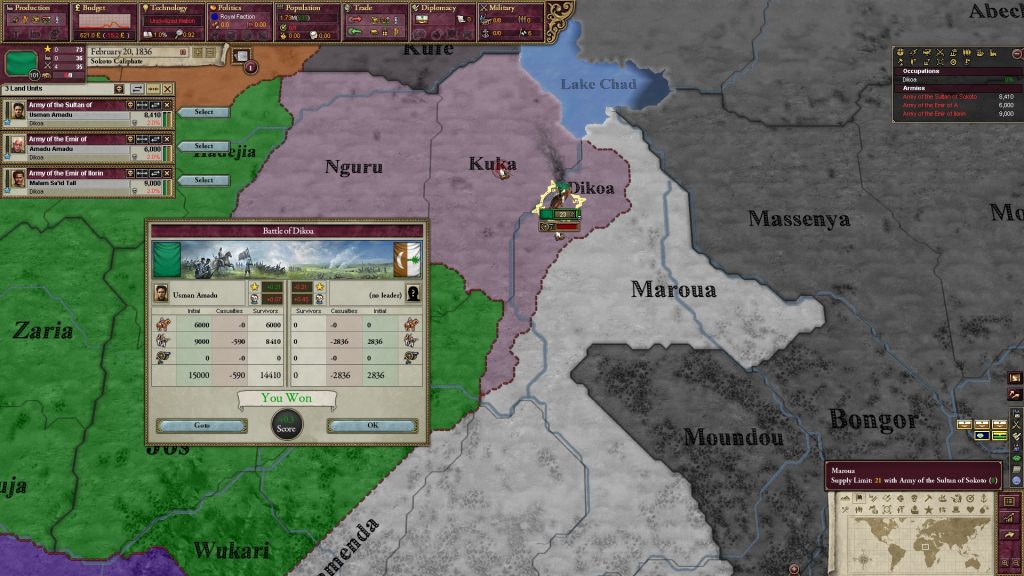“What-if” history tends to get a bad reputation in the world of academia for being imprecise and subjective, yet the process behind making alternative history models for video game scenarios can be as complex as any proper research. How does alternative history benefit the gaming experience and how are these scenarios made?
Introduction
While a number of alternative history settings in mainstream video games such as Wolfenstein or the Bioshock series typically make little or no attempt to justify the plausibility of their scenario, there is a subset of games that are willing to effectively place themselves in a semi-academic debate. In these games the alternative history scenario functions like an argument about how certain historical processes could have developed based on real-world history similar to it. Instead of hand-waving away criticism as irrelevant to the player’s enjoyment of the alternative world, the developers of these games engage with primary source material as well as their often academically interested audience to create a consensus on what could happen if world history had taken a different turn than it did in real life. The best place to find these types of games, in my opinion, is the Paradox Interactive modding community. Paradox games like Victoria 2 and Hearts of Iron IV already are historical sandbox simulations in and of themselves; you start off in a historically accurate time period and the actions of the player have the potential to change the course of history. The game then simply rolls with what it is given from there. Modders, who are most often young non-academics with an interest in history, dive much deeper into the intricacies of the worlds they create and challenge the dominant discourse by allowing for the representation of the disempowered of our history.
In November of 2020 Robert Houghton held a digital lecture for VALUE on why Paradox games deviate from history and how the developers deal with a lack of data in the historical periods they want to depict. Houghton touches on many of the same points as this article does so the VOD of this lecture is linked below.
Creating Divergencies
To better understand the theoretical uses of alternative history, it first has to be established how they are made. The first step in making any alternative history scenario is asking a “what-if” question. This can in theory be anything you want, such as “what if Germany won [insert world war here]” but will typically be more difficult to justify the further back in history you go. This establishes your point of divergence and forms the basis of the world you intend to create. What separates a more casual setting from a semi-academic one is what happens next; historical figures and world events that played a role in and around the time of your setting need to be fitted in in such a way that their presence makes sense, then a narrative needs to be developed that the player can follow along with. The more effort is put into justifying the choices made here, the better a scenario can withstand critique.
A point of divergence functions as a springboard for the constant justification of the historical processes that take place within the scenario, which works about the same as an academic or historiographical debate on a model of history. This model presents an argument about real historical processes that can be turned into interactable mechanics in a video game, which Hearts of Iron IV and especially Victoria 2 already do to an extent. In these games the player is given 10 to 100 years of simulated history based on mechanics that allow for these alternative scenarios to emerge on their own. The Paradox community has a tradition where at the end of a particularly interesting play session the player writes an AAR (After Action Report) detailing what took place in their game.
An example is Jihad on the Savannah: A Vic2 serious Sokoto AAR by Paradox forum user mad orc who goes into great detail explaining the history behind the Fulani jihads in West Africa throughout his game as Sokoto in Victoria 2. To briefly summarise how these events unfolded in real life; the Hausa lands that Sokoto comprises had traditionally been top-down islamic caliphates where the aristocracy embraced the faith and the population remained pagan, much like the early Christening of England in the Sub-Roman period. The 18th century Wahabist movement reached Sokoto in around the time Victoria 2’s setting kicks off and a Fulani named Usman dan Fodio declared himself the Madhi (saviour) of his people, which led to the establishment of an empire in his people’s name that lasted until 1903.
The element of player control in Sokoto and the randomness of the computer-controlled rest of the world allows the game to simulate every single day from 1836 to 1936 and thus generates thousands of alternative historical events. It is however up to the player to interpret what these events mean for their campaign, as the simulation’s vast array of possibilities means these day-to-day events need to undergo some historical scrutiny to make sense.
As an example, below is mad orc’s battle of Dikoa. The game simply simulates two armies clashing here and gives you a casualty list at the end of it. With some creative writing, mad orc turns this statistic into the following description of the battle:
Dikoa, located at 12 ° 02 ′ 10 ″ north, 13 ° 55 ′ 05 ″ east and at an altitude of 298 m was an important hub of commerce in the area, even more so than the Bornu capital of Kuka. The defenders gathered inside a sturdy fort that had been built in the middle of the town. Capturing this fort would have been a very easy job for the attackers due to their sheer numbers, but the reality was different. This was not Europe or the Americas where entire armies marched as one single unit under the supreme command of their commander. This was a ragtag band of armed cattle-herders behind all their Jihadist pride. In this part of the world, if a settlement went on the defensive, then more than 90% of the men would commence to looting the surrounding countryside looking for anything of value that they could find. Thus, only a few hundred men actually remained with the general to assault the fort. As a result it would take many weeks to actually capture the town.
This battle now carries significance throughout the rest of the campaign. So does the death of the reigning caliph, future wars, contacts with westerners etc. This, on top of the actual stored game-state you can export and modify, becomes the baseline upon which a full alternative history scenario can be built. Sokoto could become a dominant power in West Africa over the course of this campaign which has the potential to repel European colonisation attempts like a second Ethiopia. The player-base has made a converter program that can export completed Victoria 2 games to Hearts of Iron IV which could push this campaign as far as into the mid 20th century. An AAR like mad orc’s has chapters full of both creative writing and historical research to explain the events of the game beyond what the mechanics allow for and these stories often have a fair amount of research into the history of the country and region they are about put into them.
Representation through Alternative History
The example of a Sokoto-focused 100 year campaign segues nicely into what I believe to be the main benefit of alternative history models. It ties into why I have been referring to them as alternative rather than alternate, too. While there is a reasonable amount of information on our real-world pre-colonial Africa, most of it is either directly from or derived of European secondary sources. Indeed, a significant part of Africa’s history was passed on through generations of oral tradition rather than written down and stored in a library. This makes it very difficult to represent these areas and peoples without a European lens, unless we can simulate history through an alternative model.
These in-depth historical sandbox games allow for exactly that. Rather than just giving the player an alternate version of history it presents a concrete alternative where the underrepresented of our world can rise to prominence. For Africa especially, the Paradox interactive games allow you to really explore the early modern pre-colonial period and use the game mechanics as a simulated version of that missing history we only really know of by second hand accounts. The opportunity to do this is also entirely in the hands of the player-base as the modding community is at the forefront of this trend at the moment. The alternative histories that are created in mods give voices to the unrecognised in history, even if those voices have previously gone unrecorded by traditional historians.
Where commercial heavyweights such as the aforementioned Wolfenstein and Bioshock do play around with alternative history tropes they use them to bring back empowered peoples of the past. Whatever research goes into the worldbuilding in those games is more to create a fantasy the player is willing to suspend their disbelief over than a simulation of a world where a disempowered group rose to prominence. For people outside of these groups this is usually not an issue as their experience with the gameplay and story is not impacted, and yet these major titles are missing out on an opportunity to give their games something extra; a position within a historiographical debate.
Paradox game modding and the community based around it has seized the opportunity to its fullest, all without any significant corporate backing. Players with coding experience make alternative histories alongside players versed in history and can so present versions of our world with totally different power relations. The game mechanics that allow for all this modability have already inspired numerous AAR’s that could be turned into fully fledged game experiences with a willing coder at the helm. Alternative histories provide us with ways to represent other voices than those of the historically empowered. Furthermore, mods created by non-historians require lots of research, and the process of mod-making is by itself a form of historical research. Putting these people away as ‘laymen’ is not justified. They are either aspiring historians themselves or part of the sphere of public history, that is why they and their work are valuable.
As one last example I want to introduce this video on another Paradox title Crusader Kings III, which is a guide to all the interesting nations in Africa. Although I am not as familiar with this game as with the ones set in modern times, the video illustrates quite well how these games handle alternative historical simulation and the gamification of pre-colonial Africa. Crusader Kings III’s history starts (at the earliest) in 867 and so this guide also serves as an introduction to the pre-colonial kingdoms in Africa in the 9th century, which the player can let rise to prominence throughout their campaign.

Jochem ‘Guthixian’ Scheelings is an MA student in African Studies at the University of Leiden and Intern at VALUE. He is aiming to specialise on crossing the boundaries between gaming and academia in his own field of expertise and maintains a broad interest in all depictions of Africa in video games. His speciality is immersive historical simulators by Paradox Interactive. Tweet him at @Guthixian_VALUE

